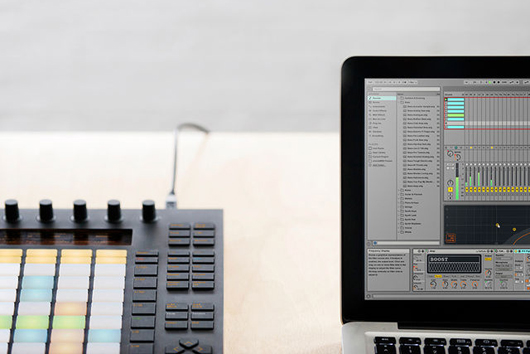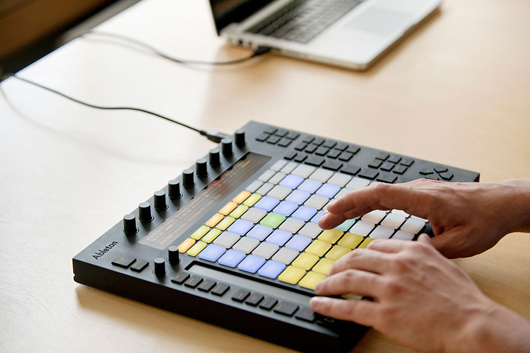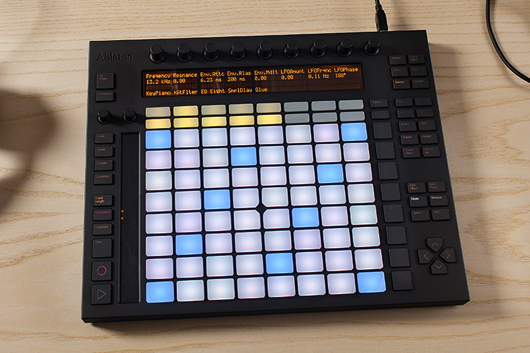Review: Ableton Live 9 and Push
Along with Live 9, Ableton has finally brought to the market its first official piece […]

Along with Live 9, Ableton has finally brought to the market its first official piece of hardware under its own name, the Push control surface. To a much greater degree than similar products before it (like, say, the Akai APC40), Live’s new hardware and software are thoroughly interwoven, and in many ways function as one. Made in conjunction with Akai, Push feels, for the first time, like a clear imagining of Ableton’s software as a hardware instrument.

How They Look
Though it’s only a controller and not an audio interface (which would have been nice), Push is heavy, weighing in at 6.6 pounds. And for good reason: The hardware is top of its class, and feels incredibly sturdy and responsive while looking like something out of Zomby’s fever dreams. The matte-black slab has an 8×8 grid of RGB-lit, pressure-sensitive pads, a vertical touch strip running along the side of them, and trigger buttons for editing, transport control, and more. A row of eight touch-sensitive encoders sits above an LED display for menus and parameters, and smart touches abound, like illuminated labels on function buttons that only appear when they’re relevant.
Most everything inside the Live 9 software itself looks pretty familiar. The browser has gone through some significant changes, however; the sounds list is now categorized by instrument type instead of device, and presets now have short preview clips that you can hear before loading them. Searches bring up dynamic lists that update as you type, and the bookmarks bar has been replaced by the ability to drag and drop folders from your desktop. Push’s integration with the new browser makes it easy to browse and load sounds using the encoders at the top of the device, as Live 9 has an impressively expanded library, and you’ll have your own sounds set aside in the User section. Then, of course, there’s the most interesting stuff: actually playing.
How They Work and Sound
When used with Push, creating beats and melodies in Live 9 is intuitive and fun. Add a Drum Rack and Push turns its grid into a combination of pad triggers and a step sequencer. On the bottom-left 4×4 grid is a standard drum-pad layout; moving your finger along the touch strip navigates through Drum Racks with more than 16 samples. You can control the resolution of the step sequencer, and the combination of real-time finger drumming and step-sequencer-style programming creates an interesting, unique perspective on beat creation.
Even more fun are pitched instruments. Load one up, and the Push grid changes from the step-sequencer view into its unique method of notational input. The pads become piano keys, essentially, and a scale button lets you change the key, whether it’s major, minor, or from a host of other non-Western scales. The grid can either represent only the notes in the key you’ve selected, or offer all of the notes chromatically. Whether you’re a classically trained musician or someone who plays entirely by feel, it’s an exciting new way to make tunes.
Of Live 9’s numerous internal improvements, its audio-to-MIDI feature has gotten perhaps the most attention. The software can analyze audio recordings, and convert them into MIDI data—and in testing, it works very well, whether you’re using a clip from another song or a recording of yourself humming a melody. Perhaps more important to most users’ workflow, however, is the fact that individual clips can now carry their own automation data, which can be transferred between the Session and Arrangement views. In conjunction with Push’s auto-mapped knobs, that’s a big deal.

The Bottom Line
Push has been a long time coming, and Ableton made sure that it came up with some genuinely exciting ideas before releasing it. Ableton’s marketing in the lead-up to release has been exceptionally clean, and the design of the Push hardware very much reflects this sensibility. More importantly, the device feels very much like an instrument that can be properly mastered, and the workflow brings together elements of other controllers into a more seamless whole. The machine on its own offers great flexibility for live performances, and feels like it would survive many of them.
But Push does not bring every software function into hardware. It does far more with MIDI than it does with audio or mixing, and unsurprisingly, it integrates much better with Live’s own instruments and effects than it does with external, third-party plug-ins. Keep in mind that it will likely continue to improve—this is effectively Push 1.0, and the integration between hardware and software will no doubt evolve with software updates over time.
For those new to Ableton Live, the combination of Push and Live 9 Suite ($1,198) or Push and Live standard ($948) comes at some cost (existing users can purchase the hardware by itself for $599). If you already have a means of note input that you love using, you may not particularly need Push—there are many solid grid-style controllers out there. Then again, the combination of having such immediate and smart contextual control of Live instruments, effects, and clips in a single device makes Push feel fresh, exciting and, perhaps most importantly, lots of fun to use.

